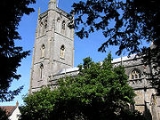
Church of St Andrew, Banwell
Encyclopedia
The mainly 15th-century parish Church of St Andrew in Banwell
, Somerset
, England is a Grade I listed building.
The body of the church has a nave
with a clerestory
, north and south aisles and a rather short chancel, considering the proportions of the rest of the church. The font dates from the 12th century and there is a carved stone pulpit
from the 15th century and a carved rood screen
built and set up in 1552, which escaped the Reformation
.
The 100 ft (30 m) high tower, which dates from around 1417, contains ten bells
dates from the 18th to 20th century and the clock is dated 1884. Bells dating from 1734 and 1742 were made by Thomas Bilbie, of the Bilbie family
. On the western face of the tower is a representation of the Annunciation. In the Virgin Mary's niche there is a lily pot symbol of purity, and a lily leaf motif also to be found in the font and pulpit.
Banwell
Banwell is a village and civil parish on the River Banwell in the North Somerset district of Somerset, England. Its population was 2,923 according to the 2001 census.-History:...
, Somerset
Somerset
The ceremonial and non-metropolitan county of Somerset in South West England borders Bristol and Gloucestershire to the north, Wiltshire to the east, Dorset to the south-east, and Devon to the south-west. It is partly bounded to the north and west by the Bristol Channel and the estuary of the...
, England is a Grade I listed building.
The body of the church has a nave
Nave
In Romanesque and Gothic Christian abbey, cathedral basilica and church architecture, the nave is the central approach to the high altar, the main body of the church. "Nave" was probably suggested by the keel shape of its vaulting...
with a clerestory
Clerestory
Clerestory is an architectural term that historically denoted an upper level of a Roman basilica or of the nave of a Romanesque or Gothic church, the walls of which rise above the rooflines of the lower aisles and are pierced with windows. In modern usage, clerestory refers to any high windows...
, north and south aisles and a rather short chancel, considering the proportions of the rest of the church. The font dates from the 12th century and there is a carved stone pulpit
Pulpit
Pulpit is a speakers' stand in a church. In many Christian churches, there are two speakers' stands at the front of the church. Typically, the one on the left is called the pulpit...
from the 15th century and a carved rood screen
Rood screen
The rood screen is a common feature in late medieval church architecture. It is typically an ornate partition between the chancel and nave, of more or less open tracery constructed of wood, stone, or wrought iron...
built and set up in 1552, which escaped the Reformation
English Reformation
The English Reformation was the series of events in 16th-century England by which the Church of England broke away from the authority of the Pope and the Roman Catholic Church....
.
The 100 ft (30 m) high tower, which dates from around 1417, contains ten bells
Church bell
A church bell is a bell which is rung in a church either to signify the hour or the time for worshippers to go to church, perhaps to attend a wedding, funeral, or other service...
dates from the 18th to 20th century and the clock is dated 1884. Bells dating from 1734 and 1742 were made by Thomas Bilbie, of the Bilbie family
Bilbie family
The Bilbie family were bell founders and clockmakers based initially in Chew Stoke, Somerset and later at Cullompton, Devon in south-west England from the late 17th century to the early 19th century....
. On the western face of the tower is a representation of the Annunciation. In the Virgin Mary's niche there is a lily pot symbol of purity, and a lily leaf motif also to be found in the font and pulpit.

